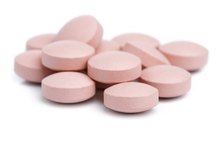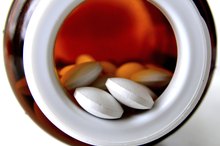Which Vitamin Is Good for Pain in the Legs?
Leg pain has a number of causes, from exercise to nerve damage caused by an injury or diabetes. It may also be the result of a condition known as restless leg syndrome -- or RLS. While leg pain caused by injury or diabetes is often irreversible, RLS and leg cramps may be caused by a lack of vitamins and nutritional deficiency. Taking certain vitamins may give you some relief, but consult your doctor first.
Vitamin B-3
Vitamin B-3 is also known as niacin and is part of the vitamin B complex. Vitamin B-3 plays an essential role in the proper circulation of blood throughout your body. The University of Maryland Medical Center indicates that inadequate blood flow throughout your legs can lead to pain. A lack of niacin in your body can also lead to restless leg syndrome, which is a condition categorized by extreme discomfort while seated or lying down. Pain can range from intense to mild. You may also experience aching, burning and itching.
- Vitamin B-3 is also known as niacin and is part of the vitamin B complex.
- A lack of niacin in your body can also lead to restless leg syndrome, which is a condition categorized by extreme discomfort while seated or lying down.
Vitamin B-12
Which Vitamins Are Good for Muscle Pains?
Learn More
Vitamin B-12 is not made in the body and therefore must be taken in by way of food from animal sources or supplements. Vitamin B-12 aids in the formation of red blood cells and the maintenance of healthy nerves. A B-12 deficiency may cause painful sensations, numbness or tingling in your legs, hands or feet, according to a report from Harvard Medical School.
Vitamin C
Vitamin C -- commonly found in citrus fruits -- is often used in treating circulatory problems that can lead to leg pain and cramping. Vitamin C acts as an antioxidant that can help reduce the buildup of plaque in your arteries, according to the University of Maryland Medical Center. Plaque buildup can reduce the flow of blood throughout your body as well as raise your risk of stroke or heart attack. Vitamin C helps keep your arteries healthy.
- Vitamin C -- commonly found in citrus fruits -- is often used in treating circulatory problems that can lead to leg pain and cramping.
Vitamin D
Are There Vitamins That Aid Muscle Flexibility?
Learn More
Vitamin D helps build strong, healthy bones and muscles. Vitamin D can be found in foods such as milk, egg yolk, liver and fish, and your body can synthesize vitamin D when your skin is exposed to sunshine. Vitamin D helps your body absorb calcium. Low amounts of vitamin D in your body can lean to muscle pain and weakness in all parts of your body -- including your legs.
- Vitamin D helps build strong, healthy bones and muscles.
Vitamin E
Vitamin E can be used as a supplement for individuals who experience restless leg syndrome or frequent leg cramps. Vitamin E can help improve the circulation of blood throughout the legs, thus decreasing pain, cramping and discomfort. Taking vitamin E can also help to protect your tissues from damage, which can help to keep your muscles strong and healthy. Vitamin E can be found in peanuts, almonds, spinach and sunflower seeds.
- Vitamin E can be used as a supplement for individuals who experience restless leg syndrome or frequent leg cramps.
- Vitamin E can help improve the circulation of blood throughout the legs, thus decreasing pain, cramping and discomfort.
Related Articles
References
- University of Maryland Medical Center: Vitamin B-3
- University of Maryland Medical Center: Vitamin C
- Harvard Medical School: Vitamin B-12 Deficiency Can Be Sneaky, Harmful
- KidsHealth.org: Vitamins
- Holick MF, Gordon CM. Patient Guide to Vitamin D Deficiency. The Journal of Clinical Endocrinology & Metabolism. 2011;96(7):1-2. doi:10.1210/jcem.96.7.zeg33a
- Sunyecz JA. The use of calcium and vitamin D in the management of osteoporosis. Ther Clin Risk Manag. 2008;4(4):827-836. doi:10.2147/tcrm.s3552
- Giovannucci E, Liu Y, Hollis BW, Rimm EB. 25-hydroxyvitamin D and risk of myocardial infarction in men: a prospective study. Arch Intern Med. 2008;168(11):1174-1180. doi:10.1001/archinte.168.11.1174
- Gorham ED, Garland CF, Garland FC, et al. Optimal vitamin D status for colorectal cancer prevention: a quantitative meta analysis. Am J Prev Med. 2007;32(3):210-216. doi:10.1016/j.amepre.2006.11.004
- Lappe JM, Travers-Gustafson D, Davies KM, Recker RR, Heaney RP. Vitamin D and calcium supplementation reduces cancer risk: results of a randomized trial. The American Journal of Clinical Nutrition. 2007;85(6):1586-1591. doi:10.1093/ajcn/85.6.1586
- Prentice RL, Pettinger MB, Jackson RD, et al. Health risks and benefits from calcium and vitamin D supplementation: Women’s Health Initiative clinical trial and cohort study. Osteoporos Int. 2013;24(2):567-580. doi:10.1007/s00198-012-2224-2
- Urashima M, Segawa T, Okazaki M, Kurihara M, Wada Y, Ida H. Randomized trial of vitamin D supplementation to prevent seasonal influenza A in schoolchildren. Am J Clin Nutr. 2010;91(5):1255-1260. doi:10.3945/ajcn.2009.29094
- Salehpour A, Hosseinpanah F, Shidfar F, et al. A 12-week double-blind randomized clinical trial of vitamin D₃ supplementation on body fat mass in healthy overweight and obese women. Nutr J. 2012;11:78. doi:10.1186/1475-2891-11-78
- Carrillo AE, Flynn MG, Pinkston C, et al. Impact of vitamin D supplementation during a resistance training intervention on body composition, muscle function, and glucose tolerance in overweight and obese adults. Clin Nutr. 2013;32(3):375-381. doi:10.1016/j.clnu.2012.08.014
- Marcinowska-Suchowierska E, Kupisz-Urbańska M, Łukaszkiewicz J, Płudowski P, Jones G. Vitamin D Toxicity-A Clinical Perspective. Front Endocrinol. 2018;9:550. doi:10.3389/fendo.2018.00550
- Ross AC, Manson JE, Abrams SA, et al. The 2011 report on dietary reference intakes for calcium and vitamin D from the Institute of Medicine: what clinicians need to know. J Clin Endocrinol Metab. 2011;96(1):53-58. doi:10.1210/jc.2010-2704
- Bouillon R, Van Schoor NM, Gielen E, et al. Optimal vitamin D status: a critical analysis on the basis of evidence-based medicine. J Clin Endocrinol Metab. 2013;98(8):E1283-E1304. doi:10.1210/jc.2013-1195
- American Academy of Dermatology. Position Statement of Vitamin D. 2010.
- Taksler GB, Cutler DM, Giovannucci E, Keating NL. Vitamin D deficiency in minority populations. Public Health Nutr. 2015;18(3):379-391. doi:10.1017/S1368980014000457
- Holick MF, Binkley NC, Bischoff-Ferrari HA, et al. Evaluation, treatment, and prevention of vitamin D deficiency: an Endocrine Society clinical practice guideline. J Clin Endocrinol Metab. 2011;96(7):1911-1930. doi:10.1210/jc.2011-0385
- Cannell JJ, Vieth R, Umhau JC, et al. Epidemic Influenza and Vitamin D. Epidemiol Infect. 2006; 134:1129-40.
- Carrillo AE1, Flynn MG, Pinkston C, Markofski MM, Jiang Y, Donkin SS, Teegarden D. Impact of Vitamin D Supplementation During a Resistance Training Intervention on Body Composition, Muscle Function, and Glucose Tolerance in Overweight and Obese Adults. Clin Nutr. 2013 Jun;32(3):375-81. doi: 10.1016/j.clnu.2012.08.014. Epub 2012 Aug 31.
- Ginde AA, Mansbach JM, Camargo CA, Jr. Association Between Serum 25-Hydroxyvitamin D Level and Upper Respiratory Tract Infection in the Third National Health and Nutrition Examination Survey. Arch Intern Med. 2009; 169:384-90.
- Giovannucci E, Liu Y, Hollis BW, Rimm EB. 25-hydroxyvitamin D and Risk of Myocardial Infarction in Men: a Prospective Study. Arch Intern Med. 2008; 168:1174-80.
- Gorham ED, Garland CF, Garland FC, Grant WB, Mohr SB, Lipkin M, Newmark HL, Giovannucci E, Wei M, Holick MF. Optimal Vitamin D Status for Colorectal Cancer Prevention: a Quantitative Meta-analysis. Am J Prev Med. 2007 Mar;32(3):210-6.
- Heaney, Robert P. “The Vitamin D Requirement in Health and Disease.” The Journal of Steroid Biochemistry & Molecular Biology 97 (2005):13-9.
- Holick MF. Vitamin D. In: Shils M, Olson J, Shike M, Ross AC, ed. Modern Nutrition in Health and Disease, 9th ed. Baltimore: Williams and Wilkins, 1999.
- National Institutes of Health Office of Dietary Supplements. Vitamin D: Dietary Supplement Fact Sheet. University of Ottawa Evidence-based Practice Center. Effectiveness and Safety of Vitamin D in Relation to Bone Health. Agency for Healthcare Research and Quality. Aug 2007: 07-E013.
- Salehpour A1, Hosseinpanah F, Shidfar F, Vafa M, Razaghi M, Dehghani S, Hoshiarrad A, Gohari M. A 12-week Double-blind Randomized Clinical Trial of Vitamin D₃ Supplementation on Body Fat Mass in Healthy Overweight and Obese Women. Nutr J. 2012 Sep 22;11:78. doi: 10.1186/1475-2891-11-78.
- Urashima M, Segawa T, Okazaki M, Kurihara M, Wada Y, Ida H. Randomized Trial of Vitamin D Supplementation to Prevent Seasonal Influenza A in Schoolchildren. Am J Clin Nutr. 2010 91:1255-60. Epub 2010 Mar 10.
- Wilkins, Consuelo H. and Yvette I. Sheline, et al. “Vitamin D Deficiency Is Associated with Low Mood and Worse Cognitive Performance in Older Adults.” American Journal of Geriatric Psychiatry 14 (2006): 1032-40.
Writer Bio
Michelle Zehr started writing professionally in 2009. She has written on health, fitness, fashion, interior design, home decorating,sports and finance for several websites. Zehr possesses a Bachelor of Arts in communication from the University of Pittsburgh, a Master of Arts in professional writing from Chatham University and a graduate certificate in health promotion from California University of Pennsylvania.









